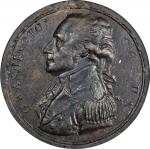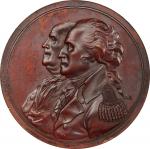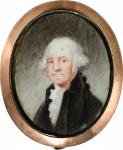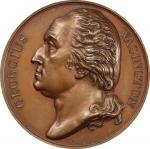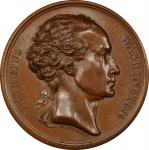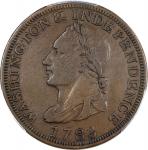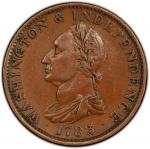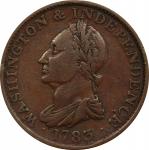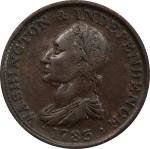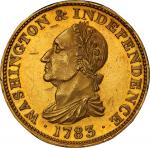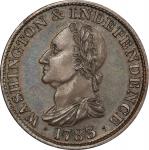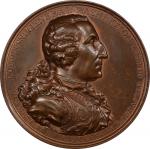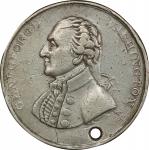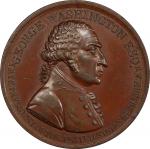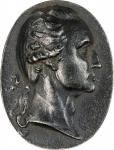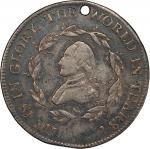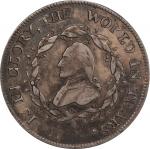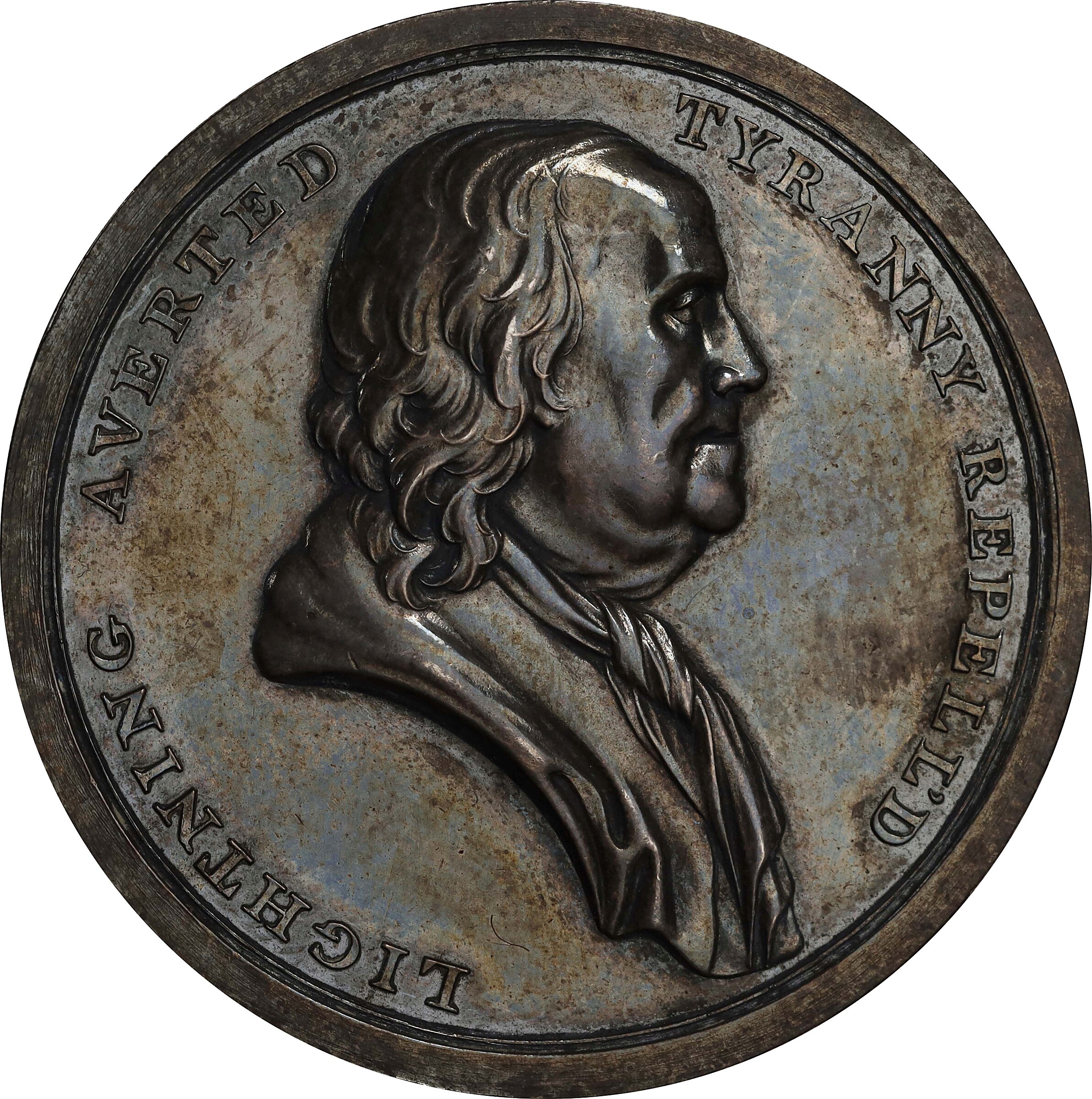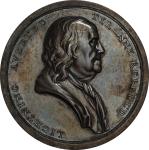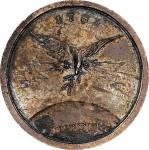Circa 1806-1808 Set of Silver Medals from Joseph Sansom’s History of the American Revolution. Each described individually below. A set of exceptional historic significance. As early as late December 1805, Philadelphia bookseller John Conrad began placing a series of local newspaper advertisements offering a new "medal, worthy of the illustrious Washington, [which] has been at length executed in Philadelphia…upon the designs of a <em>person of taste</em>, under the inspection of the director of the mint, the librarian of the philosophical society, and other gentlemen of professional ability, or acknowledged judgement."
The "person of taste" was Joseph Sansom, a citizen of Philadelphia, who designed a remarkable set of four medals intended to document the <em>History of the American Revolution</em>. In doing so, he caused to be put into metal monuments to two men, a depiction of the conflict itself, a masterful expression that it had come to a close, and one critical concept that was a remarkable cornerstone of the new nation.
Sansom was not just a person of taste, but clearly a man of means and influence, one able to get the talented John Reich to cut the dies from his designs, and to have the United States Mint strike the medals. These superbly made works have remained deeply appreciated to this day.
The first medal struck in this series was the C.C.A.U.S. medal, the design offered in the previous lot. Sansom wrote to Thomas Jefferson on December 28, 1805, presenting him an example of that first medal. On March 25, 1807, Sansom sent him an impression of the Presidency Relinquished medal, the second in the series. In the original advertising for the C.C.A.U.S., it was stated that no further medals would be produced from those dies after the close of March 1806. According to Baker, the obverse die broke early, which explains why no bronze impressions are known. Apparently, sometime after this failure and after all the C.C.A.U.S. medal impressions had been spoken for, Sansom or some family member of his decided it worthwhile to own a set of these medals. With the first issue no longer available, the threesome offered here fulfilled that wish of the complete set then possible, and remained with members and descendants of the Sansom family for more than a century.<p><p><p><p><p><strong>Circa 1806-7 Presidency Relinquished Medal. Original dies. Early impression. Musante GW-58, Baker-71, Julian PR-1. Silver. SP-62 (PCGS). </strong>40.8 mm. 441.0 grains. Deeply toned from long-term exposure to the air in the original teak frame, but some light gray remains in the fields where soft accents of pale blue iridescence add to the appeal. A trace of polish is noted on the high points, typical of early, well-appreciated medals. A few scattered marks are noted, including a nick on the cheek and a thin scratch in the plinth on the reverse. These have little effect on the eye appeal, however, as the pleasant toning and deeply prooflike fields are much more captivating. No collaring mark is noted on this piece, similar to both the Baker C.C.A.U.S. medal and the Baker specimen of this medal.<p><p><p><p>This is the second medal in Joseph Sansoms series, struck after the C.C.A.U.S. Sansom sent a copy of the Presidency Relinquished Medal to President Jefferson on March 25, 1807, so we know that dies were completed and impressions struck by that date. As such, we have revised the dating of this issue from the traditionally used "ca. 1805." A newspaper advertisement of December 14, 1807, references this medal as one of a series of three struck "at Philadelphia by Private Order…upon the Happy Establishment of the American Revolution." This advertisement is the only contemporary reference to this set of three that we are aware of. In the advertisement, this piece is specifically referred to as celebrating "the retirement of Washington." One of the most significant moments in the early Republic was when Washington personally witnessed with satisfaction the successful transition of the office and powers of the Presidency to John Adams. Such had not been witnessed by living people at the time, based on the voice of the people, and it was a moment that left many in pleasant disbelief when it transpired. It set in place the graceful and orderly manner in which the changing of the Executive would transpire for the next 220 years. <p><p><p><strong>Circa 1807 Benjamin Franklin American Beaver Medal. Julian CM-8, Betts-546, Fuld FR.M.UN.1. SP-63 (PCGS). </strong>40.4 mm. 504.7 grains. Soft blue and gold mottled iridescence accents the otherwise deep steel gray of both sides. Boldly prooflike fields and just a general trace of polish on the high points, matching exactly the surfaces of the <em>Presidency Relinquished</em> medal above. Only the most trivial marks are noted otherwise. A lovely example of this rare and historic medal. A slight edge concavity, as made. A strong collaring mark at 6 oclock, and a short collar break is seen at 9:30. The reverse rim shows that the die broke along the rim from about 7 oclock to 10 oclock, and was filed off this piece, likely by the Mint, as was a customary finishing at the time. This medal appears to have been struck in the autumn of 1807. Newspaper advertisements first announced its production in December 1807, namechecking George Clymer and Dr. Benjamin Rush, who received specimens as surviving signers of the Declaration of Independence living in Philadelphia. The reverse design is described as "the American Beaver nibbling at the Overshadowing Oak of the British Power on the Western Continent" in a newspaper piece that appeared in Philadelphia on December 1 and Annapolis on December 10. Another advertisement, of December 14, 1807, gives the brief explanatory description of "upon the Declaration of Independence," which could certainly have been the intent of the beaver just beginning to gnaw at the tree. The beaver would ultimately succeed, but at the time of the signing of the Declaration, there was still a long road ahead. The same advertisement clarified that the next and final medal in the series, that offered below, was planned but not yet prepared.<p><p><strong>Circa 1808 Peace of 1783 Medal. Musante GW-92, Baker-58, Julian CM-5. Silver. SP-62 (PCGS). </strong>40.5 mm. 483.1 grains. Soft blue and gold mottling over dark gray on the obverse, while the similarly gray reverse seems to have a soft blush of deep violet in the fields. Mild handling and trace of gentle polish on the high points as on others in this original set. A shallow collar mark at 12 oclock, similar to that seen on the early-state Baker Collection specimen, though it is better developed on that piece. A prominent collar crack at 9 oclock matches that on the Baker specimen.<p><p><p>This is the fourth and final entry in the Sansom series, and commemorates the Peace of 1783, the treaty that brought a formal end to the American Revolution. This was promoted in the aforementioned advertisement (December 14, 1807) as "intended," and commemorating the "Acquisition of Independence." Clearly, it was not ready for distribution as of mid-December, so we have adjusted the likely date of production to 1808. <p><p><p><strong>Frame. </strong>Approximately 170 x 62 mm, and 8 mm thick. A finely made period teakwood frame, with three cut outs for the medals. Joined by silver rods, capped at the ends, on two positions along the left and right sides. The top and bottom capped with a thick silver band, which is bent 90 degrees around the corners and secured on the sides with screws. The top bears the soldered original post and large suspension loop at the center. Along the surface of the top cap is neatly engraved, <em>"HISTORY OF / THE REVOLUTION."</em> Along the bottom cap is engraved, "<em>DESIGNED BY J. SANSOM F.P.S.</em>" Sansom was a Philadelphia Quaker, member of the Pennsylvania House of Representatives and a silhouette artist, so the portraits were probably key elements of his personal design. He was elected to the American Philosophical Society in 1808, clarifying "F.P.S" as <em>Fellow of the Philosophical Society</em>, and according to a brief online biography of him, he was elected in direct recognition of his success with this historic series of medals. <p><p><p>It is recorded that two other such sets existed, though not necessarily housed in the same fashion. One was in fitted silver rings and shells case engraved "MEDALLIC HISTORY OF THE AMERICAN REVOLUTION / PHILADELPHIA 1805" on one shell, and "DESIGNED BY J. SANSOM, ENGRAVED BY REICH" on the other. The set of three medals once in the John J. Ford, Jr. Collection and described and illustrated by Stewart Witham in his monograph on John Reich was broken up in the various Ford sales, leaving this set as the only original, intact threesome of Sansoms "History of the Revolution" medals in private hands. (Witham also notes a set forever ensconced in the collections of the American Philosophical Society.) Though this set has been disassembled with the medals now housed in PCGS holders, the suite is intact otherwise, including the small card documenting this sets 1932 loan to the Historical Society of Pennsylvania. A fantastic and deeply historic set of early American medals that we are delighted to be able to once again present for sale. (Total: 3 medals; 1 frame) From the Sydney F. Martin Collection. Earlier ex unspecified members of the Joseph Sansom family, leading to his great-great nephew, Robeson Lea Perot, as of 1932 (loaned by him to the 1932 Bicentennial of Birth celebrations at the Philadelphia Historical Society); Perot Family; Freeman’s Americana Sale of April 2006, lot 1; our (Stack’s) Philadelphia Americana Sale, September 2009, lot 6190; our sale of October 2018, lot 58; Anthony Terranova.

